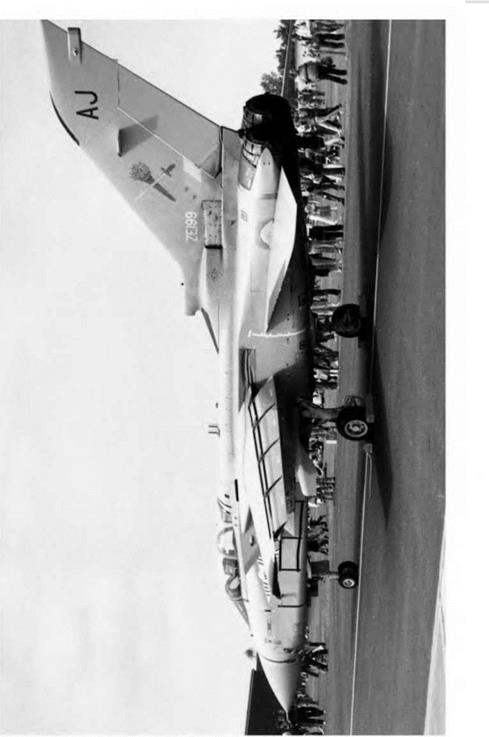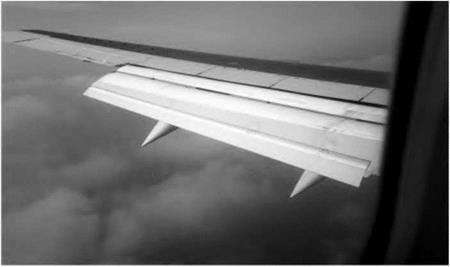Flaps
The history of flaps is longer, and just as varied, as that of slots. The plain or camber flap works on the same principle as an aileron or other control surface; it is truly a ‘variable camber’. Such flaps were used as early as the 1914-1918 war, and the original idea was the same as with slots, to decrease landing speed with flaps down, and retain maximum speed with flaps up. Their early use was almost exclusively for deck-landing purposes. It seemed at first as though the invention of slots, which followed a few years after that war, might sound the death-knell of flaps. Far from it – if anything it has been the other way round, for flaps have become a necessity on modern aircraft. Flaps, like slots, can increase lift – honours are about even in this respect so far as the plain (or camber) flap, or split flap is concerned. But these flaps can also increase drag – not, like slots, at high speed when it is not wanted, but at low speed when it is wanted. But the main difference between the effects of flaps and slots is shown in Fig. 3.33; from this it will be seen that whereas slots merely prolong the lift curve to higher values of the maximum lift coefficient, when the angle of attack of the main portion of the aerofoil is beyond the normal stalling angle, the high-lift type of flap increases the lift coefficient available throughout the whole range of angles of attack.
However it is no longer appropriate to compare the relative merits of slots and flaps because in modern aircraft it is usual to combine the two in some
form or other; and in this way to get the best of both devices (Fig. 3G). There is a large number of possible combinations, but Fig. 3.32 is an attempt to sum up the main varieties, and to describe the effect they have on the maximum lift coefficient, on the angle of the main aerofoil when maximum lift is obtained, why they improve the lift, what effects they have on the drag, how they affect the pitching moment, and so on.
From this figure it will be seen that the simpler flaps such as the camber flap, split flap and single slotted flap give a good increase in maximum lift coefficient at a reasonable angle of attack of the main aerofoil, and therefore a reasonable attitude of the aeroplane for landing; they also increase drag which is an advantage in the approach and landing.
The more complicated types such as the Zap and Fowler flap, and the double – or treble-slotted flap, give an even greater increase in maximum lift coefficient, but still at a reasonable angle of attack; while the even more complicated combinations of slots and flaps give yet greater maximum lift coefficients, but usually at larger angles of attack, and of course at the expense of considerable complication (Fig. 3H, overleaf).
Blown and jet flaps are in a class of their own since they depend on power to produce the blowing, and this may be a serious disadvantage in the event of power failure. The true jet flap isn’t a flap at all, but simply an efflux of air, or a jet stream in the form of a sheet of air ejected under pressure at or near the trailing edge of the aerofoil. This helps to control the boundary layer, and if the sheet of air can be deflected the reaction of the jet will also contribute directly to the lift.
The Krueger and other types of nose flap are used mainly for increasing lift for landing and take-off on otherwise high-speed aerofoils.
Spoilers, air brakes, dive brakes, lift dumpers and suchlike are a special category in that their main purpose is to increase drag, or to destroy lift, or both; moreover, they need not necessarily be associated with the aerofoils (Fig. 31, overleaf). They are used for various purposes on different types of aircraft; to spoil the T/D ratio and so steepen the gliding angle on high-performance sailplanes and other ‘clean’ aircraft; to check the speed before turning or manoeuvring; to assist both lateral and longitudinal control; to ‘kill’ the lift and provide a quick pull-up after landing; and on really high-speed aircraft to prevent the speed from reaching some critical value as in a dive. They will be considered later as appropriate to their various functions.
Fig 3G Flaps and slats (opposite)
Double-slotted flaps and leading edge slats are used on the Tornado. Because the flaps extend across the entire span, there is no room for ailerons, instead, the slab tailplane surfaces can move differentially as well as collectively, and this ‘taileron’ serves both for roll and pitch control.
|
|
|
|
Fig 3H Multi-element slotted flaps
Three-element slotted Fowler-type flaps extend rearwards and down as this Boeing 737 prepares to land.













